![]()
Return to Index/Main Page
| A lexicon of knife terminology: Section H | ||||||||||||||||||||||||||
| Numbers | A | B | C | D | E | F | G | H | I | J | K | L | M | N | O | P | Q | R | S | T | U | V | W | X | Y | Z |
H-1 Super Steel: A precipitation-hardened containing nitrogen and designed to be rust proof. The steels composition is: Carbon-0.15%, Chromium-14.00-16.00%, Manganese-2.00%, Molybdenum-0.50-1.50%, Nickel-6.00-8.00%, Nitrogen-0.10%, Phosphorus-0.04%, Silicon-3.00-4.50%, Sulfur-0.03%. Spyderco uses the steel for dive and rescue knives that are expected to be used in high corrosion environments such as salt water. The HRC is said to be in the high 50s but Spyderco does not perform Rockwell testing on the steel. Most consider it to be on par with AUS6 or AUS 8 steel in edge retention and durability.
Half Tang: In fixed blade knives, a tang that reaches the half way point of the knife’s handle. This is normally not a desirable quality for survival knives or knives that are expected to do heavy duty work.
Half-Congress: A Congress pattern knife that has a sheepfoot main blade on the top of the knife and small coping or pen blade on the opposite end.
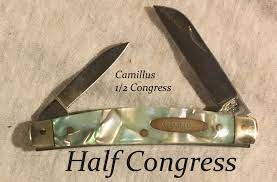
Half-Hawkbill: A hawkbill pattern knife that with a sheepfoot or only slightly curves hawkbill blade. See Hawkbill and Cotton Sampler for comparison.
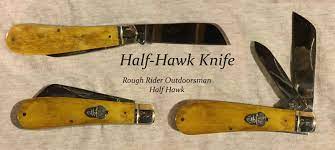
Half Whittler: A whittler knife that has a main blade and one secondary blade. The main blade is normally a pen or clip blade. The secondary blade is normally a coping blade. The handle pattern varies but is usually equal end or humpback. Compare to Whittler, Jack and Muskrat and wharncliffe ½ whittler.
Hand Guard: see Guard
Handle: The part of knife that you grip when using it. In folding knives, the handle is composed of the bolsters, pins, springs, scales and liners. In a fixed blade, the handle is composed of the tang, grip, guard, and pommel. See Scales for comparison.
Hardness: A measurement of a knife’s strength and toughness. This is usually determined through Rockwell testing. A Rockwell test between 55-62 HRC is normally desirable for knife blades depending on the type of steel. (See Strength and Toughness) Unfortunately, the Rockwell test is only part of the factor. A blade can be too hard for the metal used, thus a high Rockwell could mean the steel is too brittle and will break easily. If the steel registers a Rockwell test that is too low, the blade can warp or will dull easily. Thus hardness tends to be a balance between strength and toughness.
Hardwood: A handle material. Most knife makers will specify what type of hardwood. Ash and walnut are popular hardwoods.
Hawbaker: Today, most often the Hawbaker refers to a Muskrat style knife with one of the clip blades replaced by a sheepfoot or wharncliffe blade of equal length. The knife is named after Stanley Hawbaker. The first makers of the Hawbaker Muskrat is believed to have been Canal Street Cutlery. See Improved Muskrat for more information.
Hawkbill: A blade shaped in a sharply curved hook like that of a hawks bill with the inside curve of the blade being the cutting surface. A knife that uses this blade as its primary blade. It is used by fisherman for gutting and cutting nets and such. It is also a common blade used by gardeners. It is designed for cutting not slashing. Hawkbills are some times called a pruners, rope knife, or carpet cutters.

Heat Treatment (HT): Heat treating or tempering is done to knives to improve the steel strength. Even high carbon or top quality stainless steel will be lousy without a good heat treatment.
Hibbard: Short for Hibbard, Spencer & Bartlett Co., a Chicago based company and forerunner to the True Value Hardware. HS&B did not manufacture knives. The knives were made by several American Cutlery companies to Hibbard’s specifications and sold exclusively through their hardware stores. The tang stamp rarely identifies the cutlery company or country of origin with the possible exception of the ones made and sold in England. Despite being a store brand, the knives were known for their quality giving the Sears Craftsman brand a run for their money.
Hidden Tang: The tang is not visible in the handle. This is common in many fixed blades. Normally, if the tang runs all the way to the pommel, the knife maker will find a way to show this. In some cases holes are drilled through hidden tangs which allow the handle to be attached with screws. See Encapsulated Tang and Rat Tail.
High Carbon: A term meaning a blade has more carbon than is normally found in the particular grade of steel. Unless you know the grade of the steel, the term is meaningless.
High Carbon Tool Steel: Steel in which the carbon content exceeds 0.6%. but is less than 1%.
Hilt: In the world of knives, it is the cross bar that separates the blade for the knife handle. The hilt protects the hand from the cutting edge of the blade. (In the sword world, it is everything on the sword that isn’t the blade.)
Hirschfänger (Deer Cathcer or Hunting Dagger): A specialized Old World knife originating in Germany used in hunting large game such as deer and wild boar. The Hirschfänger has a long slender blade, often exceeding 14 inches which is used to deliver a fatal blow to wild beast by thrusting the blade into the heart. Originally the animal would be chased to exhaustion by dogs and then killed with this single thrust but as hunting evolved, the Hirschfänger became a secondary weapon used to put a wounded animal out of its misery.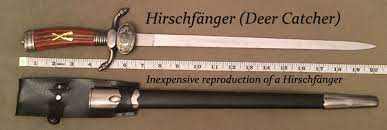
Hobo: Hobos are special types of camp/utility knives that have a folding spoon, fork and knife blade as a minimum. Most will also have a cap-lifter, can opener, and perhaps a cork-screw. See Take-A-Part Knife and Scout Knife for comparison.
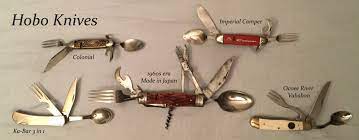
Hollow Ground: The ground surface of the blade is concave. This is normally done on a grinding stone by holding the flat side of the knife against the stone at a slight angle. Hollow grinding is the normally preferred sharpening method. Compare to Flat Grind.
Hone: To put a fine edge on a knife blade.
Hoof Hook: An "L" shaped hook like blade used to remove stones and other debris from the hoof of farm animals. Also called a stone hook. (See Horseman's Knife below for image)
Hook Remover: Hook removers are usually a small “U” sapped inset found at the top of some scaling blades that are designed so that fishermen can slide the blade in a fish’s knife and dislodge a hook. It is usually a feature on a combination blade.
Horseman’s or Equestrian: Today, these are normally a Trapper with the addition of a hoof hook. In some instances the spay blade is replaced by hoof hook allowing the manufacturer to use a standard trapper frame for production. (See also: Farrier)
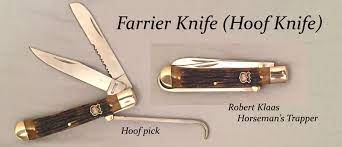
Horticulture knife: Any of a variety of knives used in horticulture or gardening. The family includes pruning, budding, grafting, Also known as Garden knives or by their specific function. To add to the confusion hawkbill, sheepfoot, coping bladed knives are ooften called pruning, grafting, and budding knives. See the various knife types for more details. Related knives include mushroom collecting, cotton samplers, and melon testers.
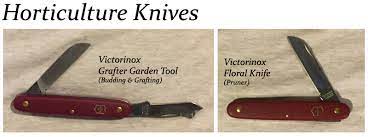
Host knife: The name given to the Camillus designed cocktail knife. The fixed blade knife features a cross bar that doubles as beverage can opener and cap lifter.
HRB Number: A number assigend to metal such as aluminum or brass and extremely soft steel when undergoing Rockwell testing.
HRC number : A number assigend to differen steels according to Rockwell. To determine a blade’s hardness an indenting tool is pressed into the surface of blade under a specified load. The load bearing penetration is then compared to a preload penetration mark. The comparison determines the Rockwell number, normally given as HRC:##. It is actually just one measure of a good knife blade and thus should not be the only consideration when choosing aknife blade. In reality, what the HRC measures is if the particular grade of steel has been heat treated (hardened) correctly. Thus you need to know the grade of steel and the HRC in order to determine if the blade is good or not.
Humpback: A slip-joint handle style in which the spring side is straight but has a small hump in the center where a main pin passes from side to side, adding strength to the knife and slip joint springs.. The pattern is very common among whittlers.
Hunter: In the traditional since, a hunter is a single edged fixed blade knife that has a half guard preventing the user's hand from encountering the sharp edge. However, as the guard does not block access to the spine, the user and use a finger to aid in the control of the blade. (see Bowie, Skinner, Folding Hunter, Fillet, and Camp knife for comparison)

Hunter, Folding see: Folding Hunter
Return to Index/Main Page